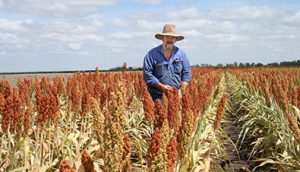Read the latest information on
Foot-and-mouth disease

Photo: Damien Ebbern
Identifying risks and having a clear plan to minimise them are the mainstays of farm biosecurity for Janerin Farms’ manager Damien Ebbern.
Janerin Farms, located west of Brookstead on the Darling Downs, consists of four neighbouring properties covering 2630 hectares of irrigated and dryland cropping.
“Our farm is busy with both winter and summer crops, so keeping on top of weeds, pests and diseases is vital to running an efficient operation,” Damien says.
“In summer we grow cotton, sorghum and mung beans and in winter we grow wheat, barley, canola and faba beans.”
Adopting the cotton best management practices (Cotton BMP) quality assurance program – which has pest management and biosecurity components – was a turning point for Janerin Farms.
“Fifteen years ago, before we adopted Cotton BMP, our farm had one of the highest incidences of Fusarium on the Downs,” Damien says.
“Now you barely see it.
“I believe this is a consequence of the introduction of farm hygiene through ‘come clean, go clean’ principles used in the program.”
Damien says farm hygiene has been paramount to increasing yields and reducing costs in Janerin Farms’ operations.
Their main biosecurity risks are the spread of soil diseases between the farms and the introduction of weeds from other farming areas.
“Our farm is busy with both winter and summer crops, so keeping on top of weeds, pests and diseases is vital to running an efficient operation,” Damien says.
“We also farm on flood country, so there is always going to be a risk of weeds, like feathertop Rhodes grass, which is a terrible weed in our cultivation, coming in with flood water.”
“We know it’s going to happen, so we deal with it by diligently spot-spraying it when we see it.”
“The sooner we get on top of it, the less problem it is in the long run.”
“If I can give any advice to other landholders, it would be to make sure they have a simple but effective biosecurity plan in place.”
“We’ve been undertaking these types of activities on Janerin for generations, but the cotton BMP helped us to pull it all together and make it a more comprehensive plan.”
“It doesn’t need to be complex, but don’t be afraid to state your needs and be sure that visitors understand your rules.”
Keeping track of visitors and ensuring they are aware of the farm biosecurity requirements is also a key to successful implementation of the plan, according to Damien.
“It starts at the gate,” he says.
“Each property has a sign with instructions for visitors to report at the main farm office to register, including their reasons for entering the farm.
“We also developed a separate form for a number of regular visitors, such as agronomists checking the crops or scientists conducting trials to keep track of their activities.
“There are specific instructions for contractors, farm workers and agronomists, which vary according to the risk.
“Our instructions include things such as only clean equipment or vehicles coming on to the property and reporting signs of unusual pests or weeds.
“We fax these instructions to contractors before they come on to the property and provide them in writing to others when they enter.
“Anyone who doesn’t want to follow our procedures is denied entry, but most people are happy to comply.
“Like all landholders, Janerin Farms has a responsibility to maintain farm biosecurity. It’s important to maintain farm biosecurity standards across the industry to protect our crops for the future.”
More information: Kym McIntyre, kym.mcintyre@daf.qld.gov.au, 0429 727 690
Kym is the Queensland biosecurity officer of the Grains Farm Biosecurity Program, which is an initiative of Plant Health Australia and Grain Producers Australia.
Acknowledgement: reproduced from an article in GRDC Ground Cover magazine